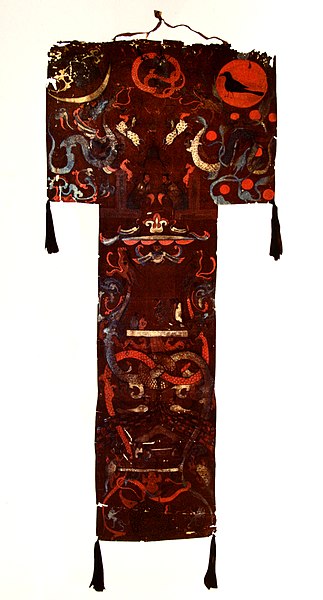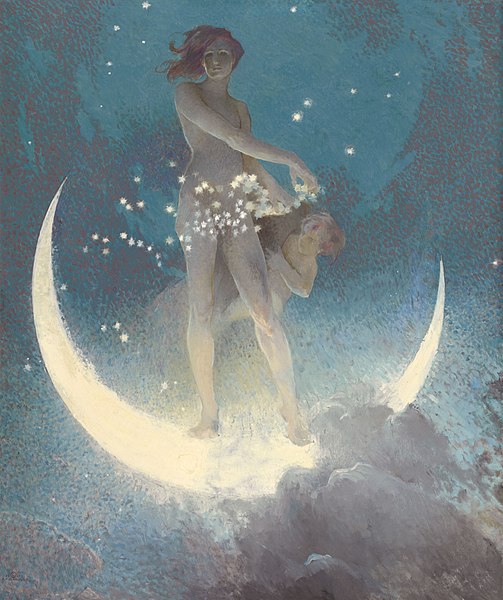 1
1title: P S Krøyer 1899 Sommeraften ved Skagens strand. Kunstneren og hans hustru
artist: Peder Severin Krøyer
date: 1899
medium: oil on canvas
dimensions: Size cm 135.0 187.0
current location: Institution:Den Hirschsprungske Samling
source: [link Den Hirschsprungske Samling]
credit: Den Hirschsprungske Samling
license:Public domain
 2
2title: Lunar eclipse al-Biruni
artist: Al-Biruni
date: 18th century [1]
medium: manuscript
current location: Institution:Library, Museum and Document Center of Iran Parliament
source: Scanned from: book reference |title=Islamic Science: An Illustrated Study |author=Seyyed Hossein Nasr |publisher=World of Islam Festival Publishing Company |year=1976 |id=ISBN|090503502X
credit: Scanned from: Seyyed Hossein Nasr () Islamic Science: An Illustrated Study, World of Islam Festival Publishing Company ISBN 090503502X
description: Illustration of different phases of the moon, from manuscript of the Kitab al-Tafhim by Al-Biruni (973-1048).
license:Public domain
 3
3title: Karnacs2
artist:
David Roberts RA, artist and Haghe, Louis, 1806-1885, lithographer.date: Sketch dated 1838; published between 1846 and 1849
source: Illus. in: Egypt & Nubia / from drawings made on the spot by David Roberts ... ; lithographed by Louis Haghe. London : F.G. moon, 1846-1849, v. 2, pt. 16. Library of Congress, Reproduction number LC-USZC4-3993 LOC-image|id=ppmsca.10482
credit: This image is available from the United States Library of Congress's Prints and Photographs division
under the digital ID ppmsca.10482.
This tag does not indicate the copyright status of the attached work. A normal copyright tag is still required. See Commons:Licensing for more information.license:Public domain
 4
4title: Isle of Graia3
artist: David Roberts
date: 27 February 1839
source: Illus. in: The Holy Land, Syria, Idumea, Arabia, Egypt and Nubia / from drawings made on the spot by David Roberts ... ; lithographed by Louis Haghe. London : F.G. moon, 1842-1845, v. 3, pts. 16-18, p. 8. Library of Congress, Reproduction number LC-USZC4-3525 LOC-image|id=ppmsca.08343 Retouched picture|Dirt and smudges removed. Banding corrected. Histogram adjusted and colors balanced, with localized adjustments to brightness and color balance.|editor=GerardM|orig=Isle of Graia.tif Modifications made by [[User:Durova|Durova]]
credit: This image is available from the United States Library of Congress's Prints and Photographs division
under the digital ID ppmsca.08343.
This tag does not indicate the copyright status of the attached work. A normal copyright tag is still required. See Commons:Licensing for more information.license:Public domain
 5
5title: Pieter Brueghel the Elder The Dutch Proverbs - Google Art Project
artist: Pieter Brueghel the Elder
date: 1559
medium: technique oil oak wood
dimensions: size cm height=117 width=163
current location: room|7 Institution:Gemäldegalerie Berlin
source: From Google Cultural Institute|WwG8mD89xbELbQ
credit: WwG8mD89xbELbQ at Google Cultural Institute, zoom level maximum
license:Public domain
 6
6title: 1794 Samuel Dunn Wall Map of the World in Hemispheres Geographicus - World2-dunn-1794
artist:
date: 1794 (dated)
dimensions: Size unit=in width=49 height=42
source: Kitchin, Thomas, <i>Kitchin's General Atlas, describing the Whole Universe: being a complete collection of the most approved maps extant; corrected with the greatest care, and augmented from the last edition of D'Anville and Robert with many improvements by other eminent geographers, engraved on Sixty-Two plates, comprising Thirty Seven maps.</i>, Laurie & Whittle, London, 1797. Geographicus-source
credit: This file was provided to Wikimedia Commons by Geographicus Rare Antique Maps, a specialist dealer in rare maps and other cartography of the 15th, 16th, 17th, 18th and 19th centuries, as part of a cooperation project.
description: An absolutely stunning and monumental double hemisphere wall map of the world by Samuel Dunn dating to 1794. This extraordinary map is so large and so rich in detail that it is exceptionally challenging to do it full justice in either photographic or textual descriptions. Covers the entire world in a double hemisphere projection. The primary map is surrounded on all sides but detailed scientific calculations and descriptions as well as northern and southern hemisphere star charts, a map of the moon, a Latitude and Longitude Analemma chart, a map of the Solar System, a Mercator projection of the world, an Analemma projection, a seasonal chart, a universal scale chart, and numerous smaller diagrams depicting planets and mathematical systems. All text is in English. We will start our survey of this map in North America, much of which was, even in 1794, largely unknown. This map follows shortly after the explorations of Captain Cook in the Arctic and Pacific Northwest, so the general outline of the continent is known. However, when this map was made, few inland expeditions had extended westward beyond the Mississippi. This map notes two separate speculative courses for the apocryphal River of the West, a northern route extending from Lake Winnipeg and a southern route passing south of Winnepeg through Pike's lake. The River of the West was hopeful dream of French and English explorers who were searching for a water passage through North America to the Pacific. In concept, should such a route be found, it would have become an important trade artery allowing the British and French, who's colonies dominated the eastern parts of North America, to compete with the Spanish for control of the lucrative Asia-Pacific trade. Little did these earlier speculative cartographers realize the bulk of the Rocky Mountains stood between them and their dreams! Slightly south of the Rivers of the West, we find the kingdom of Quivira, which is one of the lands associated with Spanish legends of the Seven Cities of Gold. In this area we can also find Drake's Harbor or Port de la Bodega and Albion. Drake's Harbor is where Sir Francis Drake supposedly landed during his circumnavigation of the globe in 1580. Drake wintered in this harbor and used the abundant resources of the region to repair his ships. He also claimed the lands for England dubbing them New Albion. Although the true location of Drake's port is unknown, most place it much further to the north. By situating it and consequently New Albion further to the south, Dunn is advocating a British rather than Spanish claim to this region. On the Eastern coast of North America we find a fledgling United States extending from Georgia to Maine. Dunn names Boston, New York, Charleston, Long Island, and Philadelphia, as well as the important smaller towns of Jamestown, Williamsburg and Edonton. South America exhibits a typically accurate coastline and limited knowledge of the interior beyond Peru and the populated coastlands. A few islands are noted off the coast, including the Galapagos, which are referred to as the Inchanted Islands. The Amazon is vague with many of its tributaries drawn in speculatively. Dunn and d'Anville have done away with the popular representation of Manoa or El Dorado in Guyana, but a vestigial Lake Parima is evident. Further south, the Laguna de los Xarayes, another apocryphal destination, is drawn at the northernmost terminus of the Paraguay River. The Xaraiés, meaning Masters of the River were an indigenous people occupying what are today parts of Brazil's Matte Grosso and the Pantanal. When Spanish and Portuguese explorers first navigated up the Paraguay River, as always in search of El Dorado, they encountered the vast Pantanal flood plain at the height of its annual inundation. Understandably misinterpreting the flood plain as a gigantic inland sea, they named it after the local inhabitants, the Xaraies.
license:Public domain
 7
7title: Maria von Braun 6330121 edited
artist: unknown
date: 1963-03-01
medium: photography
source: NASA-image|center=MSFC|id=MSFC-75-SA-4105-2C link
credit: This image or video was catalogued by Marshall Space Flight Center of the United States National Aeronautics and Space Administration (NASA) under Photo ID: MSFC-75-SA-4105-2C.
description: This is a portrait of Maria von Braun, wife of the famous Marshall Space Flight Center (MSFC) director Wernher von Braun. Her husband, Wernher, who led America to the moon, served as MSFC’s first director from July 1, 1960 until January 27, 1970.
license:Public domain
 8
8title: Arthur Streeton Golden summer, Eaglemont - Google Art Project
artist: Arthur Streeton
date: 1889
dimensions: w1526 x h813 cm
current location: National Gallery of Australia, Canberra
credit: 5gFJ9OW2MC90rQ at Google Cultural Institute maximum zoom level
license:Public domain
 9
9title: Banière funéraire, peinture sur soie, Chine
artist:
Unknown authordate: 168-145 BCE
source: from ''Le Musée absolu'', Phaidon, 10-2012
credit: from Le Musée absolu, Phaidon, 10-2012
description: Funeral banner, painting on silk, from the tomb #1 of Mawangdui, Western Han period. Hunan Provincial Museum, Changsha, China. 2.05 x 0.92 m. This 6¾ foot long Western Han painting on silk was found draped over the coffin in the grave of Lady Dai (c. 168 BC) at Mawangdui near Changsha in Hunan province, China. The scenes depicted on it seem to illustrate the journey of the woman's soul. The top section shows the heavenly realm, complete with dragons, leopards, and hybrid creatures. At the corners are the crow that symbolizes the sun and the toad that symbolizes the moon, the pairing of the sun and moon representing the cosmic forces of yin and yang.
license:Public domain

title: Edwin Blashfield Spring Scattering Stars
artist: Edwin Blashfield
date: 1927
source: [link Heritage Auctions]
credit: Heritage Auctions
license:Public domain





